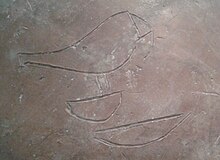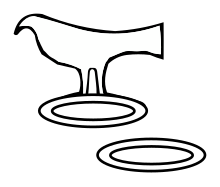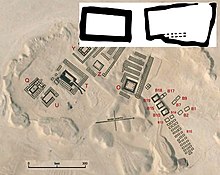Iry-Hor
| Iry-Hor | ||||||||
|---|---|---|---|---|---|---|---|---|
| Ro, Irj-Hor, Iri(-Hor) | ||||||||
 Signsr-Ḥrinscribed on a large vessel from the tomb of Iry-Hor,Ashmolean Museum | ||||||||
| Pharaoh | ||||||||
| Reign | Early to Late32nd century BC[1] | |||||||
| Predecessor | uncertain;Crocodile?Scorpion I?Double Falcon? | |||||||
| Successor | Ka | |||||||
| ||||||||
| Burial | Chambers B1, B2,Umm el-Qa'ab | |||||||
| Dynasty | Dynasty 0 | |||||||
Iry-Hor(orRo[2];fl. c.3170 BC) was a predynasticpharaohofUpper Egyptduring the32nd century BC.[1]Excavations atAbydosin the 1980s and 1990s[3][4][5]and the discovery in 2012 of an inscription of Iry-Hor inSinaiconfirmed his existence.[1]Iry-Hor is the earliest ruler of Egypt known by name and is sometimes cited as the earliest-livinghistorical personknown by name.[6]
Name[edit]
Iry-Hor's name is written with the Horus falcon hieroglyph (Gardiner sign G5) above amouth hieroglyph(Gardiner D21). While the modern reading of the name is "Iry-Hor",Flinders Petrie,who discovered and excavated Iry-Hor's tomb at the end of the 19th century, read it "Ro", which was the usual reading of the mouth hieroglyph at the time.[7][8]
Given the archaic nature of the name, the translation proved difficult and, in the absence of a better alternative,Ludwig D. Morenzproposed that the literal translation be retained, giving "Horus mouth".[9]
In the 1990s,Werner KaiserandGünter Dreyertranslated Iry-Hor's name as "Companion of Horus".[3]
Two other attempts at translations presuppose that Iry-Hor was not a king, since his royal status was still controversial at the time of their publication. The EgyptologistsJürgen von BeckerathandPeter Kaplonyproposed that the known inscriptions referred to a private person whose name is to be read Wer-Ra,wr-rꜣ(lit. "great mouth" ), i.e. reading the bird above the mouth-sign as theswallow hieroglyph G36rather than the Horus falcon. They translated the name as "Spokesman" or "Chief".[10]Toby Wilkinson,considering the person in question to have been aslaveof a king, translated the signs as "Property of the king".[11]
Identity[edit]


Controversy regarding his social status[edit]
Until 2012, the name of Iry-Hor had not been found in or next to aserekh,so the identification of Iry-Hor as a king was controversial.Toby Wilkinsoncontended that Iry-Hor wasnota king, but a slave of a king.[11]EgyptologistsJürgen von BeckerathandPeter Kaplonyalso initially rejected the identification of Iry-Hor as a king and proposed instead that the known inscriptions refer to a private person whose name is to be read Wer-Ra,wr-rꜣ(lit. "great mouth" ), i.e. reading the bird above the mouth-sign as theswallow hieroglyph G36rather than the Horus falcon. They translated the name as "Spokesman" or "Chief".[10]
EgyptologistsFlinders Petrie,[2]Laurel Bestock[8]andJochem Kahl[12]nonetheless believed that he was indeed a real ruler.
Following the excavations at Abydos and the discovery of an inscription of Iry-Hor in the Sinai in 2012, Wilkinson's hypothesis is now rejected by most Egyptologists and Iry-Hor is widely accepted as a predynastic king of Egypt.[1][13][14]
Resolution[edit]
Dreyer's excavations of the necropolis of Abydos revealed that Iry-Hor was in fact well attested there with over 27 objects bearing his name and that his tomb was of royal proportions.[15] Furthermore, in 2012 an inscription mentioning Iry-Hor was discovered in the Sinai, the inscription comprising furthermore an archaic empty serekh on the right of Iry-Hor's name.[1]The inscription mentions the city ofMemphis,pushing back its foundation to before Narmer and establishing that Iry-Hor was already reigning over it. Following this discovery, most Egyptologists, including G. Dreyer and the discoverers of the inscription, Pierre Tallet and Damien Laisney, now believe that Iry-Hor was indeed a king.[1] Continuing excavations of Iry-Hor's tomb at Abydos by Dreyer established that the tomb was of similar dimensions and layout as those of Ka andNarmerand must, therefore, have belonged to a king. This was consequently accepted by von Beckerath and Iry-Hor is now the first entry in the latest edition of von Beckerath'sHandbook of Egyptian Pharaohs.[16]
Reign and attestations[edit]

Iry-Hor was most likelyKa's immediate predecessor[17]and thus would have reigned during the early32nd century BC.He probably ruled fromHierakonpolisoverAbydosand the wider Thinite region and controlled Egypt at least as far north asMemphis,since the Sinai rock inscription relates a visit of Iry-Hor to this city.[1][18]The EgyptologistsTalletandDamien Laisneyfurther propose that Iry-Hor also controlled parts of theNile Delta.[1]
He was buried in the royal cemetery ofUmm el-Qa'abnear Ka,Narmerand the First Dynasty kings. Iry-Hor's name appears on clay vessels from his tomb inAbydosand a clay seal with the hieroglyphs forr-Ḥrwas found inNarmer's tomb and may refer to Iry-Hor. In total, no fewer than 22 pottery jars incised with Iry-Hor's name have been in Abydos as well as at least five ink-inscribed fragments and a cylinder seal.[15] A similar seal was also found far to the north in the tomb Z 401 ofZawyet el'AryaninLower Egypt.[3][19]An incision on a spindle whorl found inHierakonpolisduringJames E. Quibelland Petrie excavations there in 1900 may refer to him.[20]Finally, the discovery of a rock inscription of Iry-Hor in the Sinai constitutes his northernmost attestation. The inscription shows the name of Iry-Hor on a boat, next to the wordInebu-hedjmeaning "white walls", the ancient name ofMemphis.[1]
Tomb[edit]

Iry-Hor's tomb is the oldest tomb of the Abydos necropolis B in theUmm el-Qa'ab.[21]It comprises two separate underground chambers B1 (6 m × 3.5 m) and B2 (4.3 m × 2.45 m) excavated byPetriein 1899 and later by Werner Kaiser.[2][22]A further chamber, now known as "B0", was uncovered during re-excavations of Iry-Hor's tomb in the 1990s.[19]These chambers have a size similar to those found in the tombs of Ka and Narmer. No superstructure, if there ever was one, survives to this day. Chamber B1 yielded jar fragments incised with his name.[21]Chamber B2 produced another incised jar fragment, a seal impression, several ink inscriptions and vessel fragments bearing the names of Ka and Narmer. Parts of a bed were also found onsite.[3]
See also[edit]
- Naqada III,also called Dynasty 0
- Kushim
- Enmebaragesi
References[edit]
- ^abcdefghiP. Tallet, D. Laisnay:Iry-Hor et Narmer au Sud-Sinaï (Ouadi 'Ameyra), un complément à la chronologie des expéditios minière égyptiene,in: BIFAO 112 (2012), 381-395,available online
- ^abcPetrie, Flinders(1900).The Royal tombs of the earliest dynasties.pp. 29 & 30.
- ^abcdeKaiser, Werner;Dreyer, Günter(1982). "Umm el-Qaab. Nachuntersuchungen im frühzeitlichen Königsfriedhof: 2. Vorbericht".Mitteilungen des Deutschen Archäologischen Instituts Kairo (MDAIK)(in German).38.Berlin:German Archaeological Institute,Orient-Abteilung, de Gruyter: 211–246.ISSN0342-1279.
- ^Kaiser, Werner; Dreyer, Günter (1993). "Umm el-Qaab. Nachuntersuchungen im frühzeitlichen Königsfriedhof 5./6. Vorbericht".Mitteilungen des Deutschen Archäologischen Instituts Kairo (MDAIK)(49): 56.
- ^Kaiser, Werner; Dreyer, Günter (1996). "Umm el-Qaab. Nachuntersuchungen im frühzeitlichen Königsfriedhof 7./8. Vorbericht".Mitteilungen des Deutschen Archäologischen Instituts Kairo (MDAIK)(52): 48–57 and taf. 9.
- ^Odenwald, Sten (August 15, 2014)."Who Was the First Named Human?".Huffpost.Retrieved29 June2019.
- ^W. M. F. Petrie:Abydos I,pp. 4–6.
- ^abBestock, Laurel (2009).The Development of Royal Funerary Cult at Abydos.pp. 16, 17, 21 & 28.ISBN978-3-447-05838-4.
- ^Ludwig D. Morenz:Bildbuchstaben und symbolische Zeichen,p. 88
- ^abKaplony, Peter(1963).Inschriften der Ägyptischen Frühzeit.Vol. 1. p. 468.
- ^abWilkinson, Toby(1993). "The identification of Tomb B1 at Abydos: refuting the existence of a king 'Ro/Iry-Hor'".Journal of Egyptian Archaeology.79.London: Egypt Exploration Society: 91–93.ISSN0307-5133.
- ^Jochem Kahl:Das System der ägyptischen Hieroglyphenschrift in der 0.-3. Dynastie,pp.96–101.
- ^van den Brink, Edwin C. M. (1996). "The incised serekh signs of Dynasties 0–1. Part I: complete vessels". In Spencer, A. Jeffrey (ed.).Aspects of Early Egypt.London: British Museum Press. pp. 140–158.ISBN978-0-7141-0999-2.
- ^van den Brink, Edwin C. M (2001)."The incised serekh signs of Dynasties 0–1. Part II: Fragments and Additional Complete Vessels"(PDF).archeonil.fr.11.RetrievedApril 23,2021.
- ^abEdwin C. M. van den Brink:Two Pottery Jars Incised with the Name of Iry-Hor from Tomb B1 at Umm El-Ga'ab, Abydos,available online,in:Zeichen aus dem Sand, Streiflichter aus Ägyptens Geschichte zu Ehren von Günter Dreyer,Eva-Maria Engel, Vera Müller and Ulrich Hartung editors, Harrassowitz Verlag, Wiesbaden, 2008,ISBN978-3-447-05816-2
- ^Jürgen von Beckerath:Handbuch der ägyptischen Königsnamen,Münchner ägyptologische Studien, Volume 49, Mainz: P. von Zabern, 1999,ISBN3-8053-2591-6,Archived2015-12-22 at theWayback Machinepp. 9, 36–37
- ^Winfried Barta:Zur Namensform und zeitlichen Einordnung des Königs Ro,in: GM 53, 1982, pp. 11–13.
- ^Owen Jarus, Live Science,Early Egyptian Queen Revealed in 5,000-Year-Old Hieroglyphs,[1][2]
- ^abBaker, Darrell D.The Encyclopedia of the Pharaohs: Volume I - Predynastic to the Twentieth Dynasty 3300–1069 BC,Stacey International,ISBN978-1-905299-37-9,2008, p. 156
- ^James E. Quibell,Flinders Petrie:Hierakonpolis. Part I. Plates of discoveries in 1898 by J. E. Quibell, with notes by W. M. F. P[etrie],London 1900,available online
- ^abRaffaele, Francesco (2003)."Dynasty 0"(PDF).Aegyptiaca Helvetica.Basel, Switzerland:Schwabe:99–141.ISSN1017-5474.
- ^Kaiser, Werner (1964). "Einige Bemerkungen zur ägyptischen Frühzeit".Zeitschrift für Ägyptische Sprache und Altertumskunde.91(2): 86–124.doi:10.1524/zaes.1964.91.2.86.S2CID201840428.
